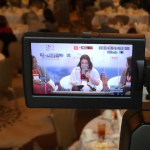The most challenging part of producing an event with an online audience may not be getting the technology right, but this: When you’re streaming from a face-to-face event, how do you encourage the online audience to become more than passive observers?
We asked three VEI Advisory Board members — Emma King, DES, vice president, learning & event strategy, INXPO; Amanda Marijanovic, DES, founder and chief creative officer, INNERACTION; and Lauren Benavente, DES, online meeting planner, EDUCAUSE — for their best ideas for creating online engagement.

King: Don’t let the virtual audience feel like a fly on the wall. Speak to them from the physical stage, welcome them to the venue, encourage them to interact with their peers, and list the ways that they can engage. Call out those who are highly engaged on the platform — give them recognition for their involvement (who doesn’t like to be praised and recognized?).
Leverage tools that enable the virtual audience and physical audience to interact. Use polling or a chat-room feature from mobile devices like Second Screen and give them a reason to interact and touch the keyboard every two to three minutes during live presentations. And — just as you would at the physical venue — schedule timed events within the hybrid meeting when people can meet and greet, participate in a community game, and watch some exclusive content. Make them feel as important as your attendees at the physical venue.
Marijanovic: Your online audience has a myriad of distractions at their fingertips to derail their focus from the content. And more than likely, they haven’t cleared their calendar so they can join you online for several days straight. So it’s important to design your hybrid experience in parallel with your face-to-face offering, with careful thought on how to best attract — and then maintain — their attention.

Make participation a requirement. No voyeurs allowed! If your online audience feels as though they’re simply watching content from the sidelines vs. having an active role in the dialogue, they’ll quickly tune out or multitask. Engagement tactics like polling and an active chat log with a virtual moderator to encourage conversation ensures the online audience is touching their keyboards often and staying engaged in what they’re learning. Equally important is having a live moderator in the session itself to ask presenters questions on behalf of the remote audience.
Don’t allow for “dead air.” While your face-to-face attendees are off taking a lunch break or at a session that wouldn’t translate well online, deliver exclusive content to your online audience. Consider having a live “in-studio” host to conduct interviews with keynote speakers and other thought leaders to forge a more direct connection with the speakers and address the specific questions of the online audience. You can also use this tactic to engage your online audience first thing in the morning before your general session stream starts.
And, if converting your online participants to future face-to-face attendees is part of your hybrid strategy, it’s also a good idea to show sneak peeks of the on-site happenings that attendees can only experience in person.
Benavente: Ditch the microphone stands and use a throwable microphone. Many times, the only way our virtual audience is able to keep up with questions from the face-to-face audience is through an onsite microphone. Typically, we’ll stagger a few microphone stands down the aisle of large session rooms.

However, as an attendee sitting in a lecture-style room, making your way to those microphones proves to be a challenge. No one wants to have to excuse themselves to go past people, occasionally stepping on a toe or knocking over a coffee cup. Some attendees choose to skip the journey to the microphone altogether and remain quiet instead. A throwable microphone like Catchbox encourages participants to speak up, ask questions, and most importantly, it gives the virtual audience a more colorful experience coupled with more conversation. Plus, it’s fun to watch.
And when you add a virtual audience moderator in the on-site room to relay questions from the virtual audience, you’ll get even more engagement and participation.




